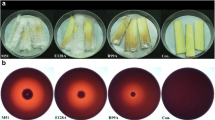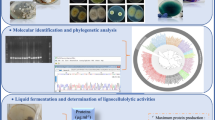Abstract
The distribution of acetyl esterase was studied in 30 strains of wood-rotting fungi. A screening test on agar plates using glucose β-d-pentaacetate as a substrate indicated that all tested fungi produced acetyl esterase to form a clear zone on the culture. All fungi also showed positive responses in an agar test using carboxymethyl cellulose acetate. Enzyme assay showed that extracellular acetylxylan esterase activity was present in the filtrates of wood-meal culture of all these fungi. The ratio of fungal acetylxylan esterase activity to 4-nitrophenyl acetyl esterase activity were higher than that of porcine liver esterase, indicating that fungal esterases have high affinity for acetylated carbohydrates. Acetyl esterase is suggested to be distributed widely in wood-rotting fungi for degradation of native acetylated hemicelluloses.
Similar content being viewed by others
Literature cited
Biely, P. 1985. Microbial xylanolytic systems. Trends in biotechnol.3: 286–290.
Biely, P., Puls, J. and Schneider, H. 1985. Acetyl xylan esterase in fungal cellulolytic systems. FEBS Lett.186: 80–84.
Biely, P., Mackenzie, C. R., Puls, J. and Schneider, H. 1986. Cooperativity of esterases and xylanases in the enzymic degradation of acetyl xylan. Bio/Biotechnol. (USA)4: 731–733.
Bouveng, H. O. and Lindberg, B. 1965. Native acetylated wood polysaccharides. Methods in carbohydrate chemistry, vol. 5 (ed. by Whistler, R. L.), pp. 147–150. Academic Press, London.
Highley, T. L. 1976. Hemicellulases of white- and brown-rot fungi in relation to host preferences. Mater. Org.11: 33–46.
Imazeki, R. 1989. Polyporaceae. In: Colored illustrations of mushrooms of Japan, vol. II, (ed. by Imazeki, R. and Hongo, T.), p. 172. Hoikusha Pub., Osaka. (In Japanese).
Kirk, T. K., Schulz, E., Conners, W. J., Lorenz, L. F. and Zeikus, G. 1978. Influence of culture parameters on lignin metabolism byPhanerochaete chrysosporium. Arch. Microbiol.117: 277–285.
Lee, H., To, R. J. B., Latta, R. K., Biely, P. and Schneider, H. 1987. Some properties of extracellular acetylxylan esterase produced by the yeastRhodotorula mucilaginosa. Appl. Environ. Microbiol.53: 2831–2834.
Poutanen, K. and Sundberg, M. 1988. An acetyl esterase ofTrichoderma reesei and its role in the hydrolysis of acetyl xylans. Appl. Microbiol. Biotechnol.28: 419–424.
Somogyi, M. 1952. Notes on sugar determination. J. Biol. Chem.195: 19–23.
Tenkanen, M., Puls, J., Rättö, M. and Viikari, L. 1993. Enzymatic deacetylation of galactoglucomannans. Appl. Microbiol. Biotechol.39: 159–165.
Timell, T. E. 1964. Wood hemicelluloses: Part I. Adv. Carbohydr. Chem.19: 247–299.
Timell, T. E. 1965. Wood hemicelluloses: Part II. Adv. Carbohydr. Chem.20: 409–482.
Tsujiyama, S. and Nakano, N. 1996. Detection and production condition of acetylxylan esterase of a wood-rotting fungus,Coriolus versicolor. Mycoscience37: 103–104.
Author information
Authors and Affiliations
About this article
Cite this article
Tsujiyama, Si., Nakano, N. Distribution of acetyl esterase in wood-rotting fungi. Mycoscience 37, 289–294 (1996). https://doi.org/10.1007/BF02461300
Accepted:
Issue Date:
DOI: https://doi.org/10.1007/BF02461300




